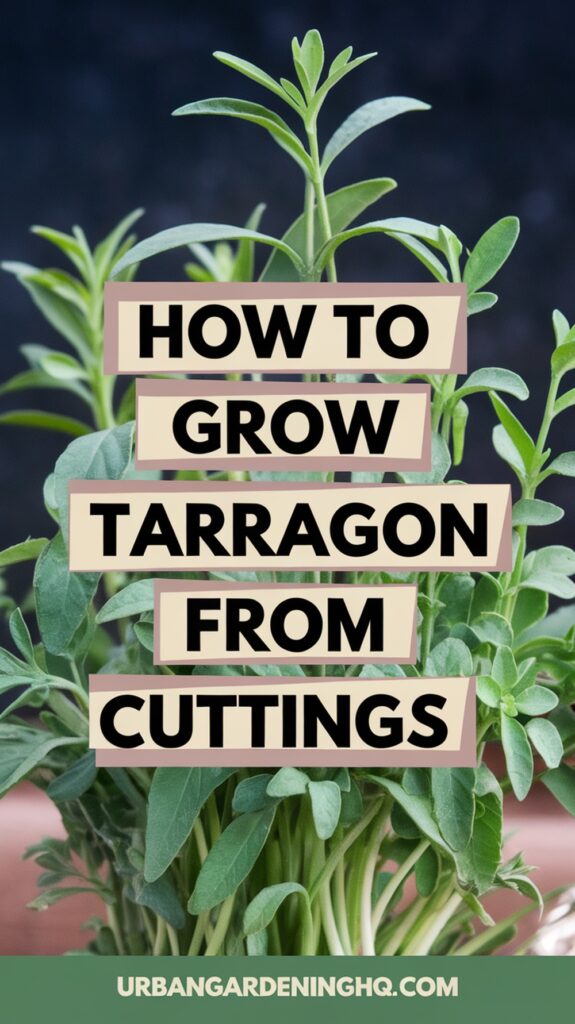Tarragon was one of the first herbs I truly struggled with—but once I learned how to grow it from cuttings instead of seeds, everything changed. Unlike many herbs, tarragon (especially French tarragon) doesn’t grow reliably from seed. In fact, most French tarragon plants are sterile, which means propagation from cuttings is the best and most dependable way to grow it.
I adore tarragon for its delicate, slightly sweet flavor with subtle anise notes. It’s fantastic in salad dressings, roasted chicken, compound butters, and even herbal vinegars. It’s also beautiful in a container garden, with its wispy green stems and fine-textured leaves.
If you’ve ever wanted to grow this refined herb but didn’t know where to begin, let me share how I do it—cuttings and all.
Choosing the Right Container for Tarragon

Tarragon has a graceful, upright habit that looks great in a medium to large pot. I usually grow mine in 10-inch-wide containers that give the roots plenty of room to spread without becoming cramped. It prefers depth, so I go for containers that are at least 10 to 12 inches deep.
Drainage is crucial. Tarragon dislikes wet feet, so I always make sure the pot has several drainage holes and I add a bit of gravel or coarse sand to the bottom. I prefer terracotta because it helps wick away moisture and keeps the roots healthy, but any breathable, well-draining pot will work.
Tarragon is also easy to move around, so growing it in a container means I can shift it to sunnier spots or bring it indoors during cooler months.
Selecting and Preparing Tarragon Cuttings
The key to success is starting with a healthy tarragon plant. I get my cuttings from an established French tarragon plant—Russian tarragon is hardier but less flavorful, so I stick with the French variety.
Here’s how I prep the cuttings:
- Choose soft, green stems about 4 to 6 inches long. Avoid anything woody.
- Cut just below a leaf node using clean, sharp scissors or pruners.
- Remove the lower leaves to expose the nodes, leaving just a few leaves at the top.
I usually take several cuttings at once to increase my success rate. Tarragon isn’t quite as fast to root as mint, but it’s still a straightforward process with a little patience.
Rooting Tarragon Cuttings in Water
While some gardeners prefer rooting tarragon in soil, I’ve had great success rooting it in water—and it’s easier to monitor progress. I fill a small glass or jar with room-temperature water and submerge the lower part of the stem, making sure at least one node is under water.
I keep the jar on a sunny windowsill that gets bright, indirect light. Direct afternoon sun can be too harsh during this stage. I change the water every 2 to 3 days to prevent bacterial buildup and to keep the environment fresh.
Roots typically begin forming within 10 to 14 days, although sometimes it takes a little longer. Once I see roots that are at least 1 to 2 inches long, I get ready to transplant.
Transplanting Rooted Tarragon Cuttings
When the roots are ready, I prepare a pot filled with a light, well-draining soil mix. I often use a blend of standard potting mix, coarse sand, and a bit of compost. Tarragon doesn’t need overly rich soil—in fact, too much fertility can make the flavor weaker—so I aim for a lean, well-aerated mix.
I plant each rooted cutting about 1 inch deep and gently firm the soil around the base. After planting, I give the pot a thorough watering and place it in a partially shaded area for the first few days. Once the plant shows signs of new growth, I move it to full sun.
Caring for Tarragon in Containers
Once established, tarragon is surprisingly easy to care for. It’s drought-tolerant, aromatic, and not overly fussy. Here’s how I maintain it throughout the growing season:
Watering
Tarragon prefers consistent, moderate watering. I let the top inch of soil dry out between waterings. Overwatering is the main issue to avoid—too much moisture can quickly lead to root rot or mold.
Sunlight
Tarragon loves sunshine. I give it 6 to 8 hours of full sun a day. If I’m growing it indoors, I place it near a south-facing window or supplement with grow lights.
Pruning and Harvesting
The more I trim my tarragon, the bushier it becomes. Once the plant is 8 to 10 inches tall, I begin harvesting by cutting back the tips just above a leaf node. This encourages branching and keeps the plant tidy.
I always harvest before the plant flowers—the leaves start to lose their flavor once blooms appear. I also dry or freeze extra tarragon leaves to use throughout the year.
Feeding
Tarragon doesn’t require heavy feeding. I give it a diluted dose of organic liquid fertilizer once a month during the active growing season, usually from late spring to early fall.
Pests and Problems
Tarragon is fairly pest-resistant, but I occasionally see aphids or spider mites. A quick rinse or a spray with insecticidal soap usually takes care of them. I also make sure the plant has good air circulation, especially during humid weather.
Final Thoughts: The Elegance of Homegrown Tarragon
Growing tarragon from cuttings might sound like something only advanced gardeners do—but in reality, it’s a simple, satisfying project that yields incredible results. There’s nothing quite like snipping fresh sprigs of this elegant herb and adding them straight to a dish.
If you’ve struggled with tarragon from seed or didn’t know where to start, I hope this guide inspires you to try propagating from cuttings instead. It’s easy, cost-effective, and a great way to grow more of what you love.
For me, tarragon has gone from being an intimidating herb to one of the stars of my kitchen garden. And it all started with a single cutting in a glass of water.

